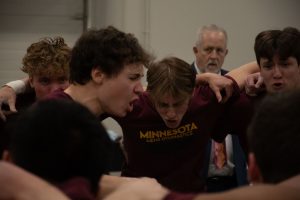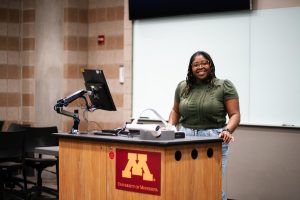Despite Tuesday’s gray weather, University officials and politicians maintained a sunny disposition at the ground-breaking ceremony for the institution’s new Translational Research Facility.
The crowd of 140 people gathered just northwest of the Huron Boulevard Parking Complex near the Lions Research Building to celebrate what officials heralded as a significant step in the University’s return to medical prominence. Attendees included Gov. Tim Pawlenty, University President Bob Bruininks, University researchers and other officials.
Funded by state bonds and private donations, the facility will turn scientific developments into patient treatments and therapies. Much of the work will focus on genetics and molecular biology.
Academic Health Center Senior Vice President Frank Cerra said the facility should be completed in about 18 months.
“I cannot tell you the feeling I had walking across this grass. Where you are sitting is where this Translational Research Facility will be,” he said, referring to a lawn that had been cleared of snow for the ceremony.
The facility’s creation is a step forward in the University’s and state’s efforts to be at the forefront of biomedical research and development.
Pawlenty declared Tuesday Translational Research Day in Minnesota and said the facility will help move educational discoveries to the marketplace and the patients who need them. He thanked legislators for helping make the facility a reality in tight fiscal times.
Pawlenty said the cold, pre-winter ceremonial setting and the University band members on hand reminded him of college football time.
Bruininks said attracting and retaining top researchers is not possible without resources such as the Translational Research Facility.
It will also provide a “badly needed link” between diverse levels of University science and medicine, he said.
“There is not a more pressing need than to support the University of Minnesota,” Bruininks said, thanking all those involved in funding and supporting the new facility.
The work of Dr. John Wagner, pediatric hematologist at the University and medical director of the University’s Stem Cell Institute, showcased the importance of the work that will be done at the translational facility, he said.
In 1999, Wagner transplanted stem cells from newborn Adam Nash into the body of his older sister Molly, Bruininks said. Molly was suffering from a rare genetic bone marrow disease called Fanconi anemia.
Using genetic information from Adam and innovative transplant techniques, Wagner injected healthy stem cells from Adam’s umbilical blood into his older sister. The new cells took over where Molly’s sick cells could not, and Molly’s bone marrow is now full of Adam’s healthy cells. Both children were happy, healthy and vibrant as they helped shovel dirt at the ceremony.
As Molly and Adam’s parents choked up, Wagner said the Nash children were an example of the medical possibilities that will come out of the new facility.
“This is all really about people,” Wagner said.








